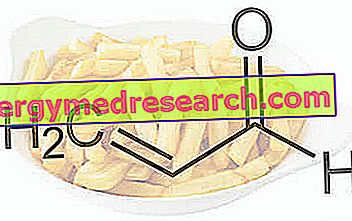What is the Acrolein

Production
The acrolein derives from the catabolism of GLYCEROL [esterified with fatty acids in triglycerides (lipids)] and is produced significantly during:
- Thermal overcoming of the "smoke point" of fats and cooking oils during cooking
- Cigarette burning (smoking)
- The incorrect fermentation of the must in the wine sector; this reaction is catalyzed by the enzymes of lactic bacteria (in case of processing error) which, starting from the GLYCERINE contained in the must, release acrolein.
NB . It is also possible to chemically reproduce the dehydration of glycerol in acrolein by the Skraup Synthesis 1.
Toxicity
Acrolein is a highly polluting and harmful contaminant for humans; it constitutes 5% of atmospheric aldehydes2 and, more than FORMALDEHYDE (50% of TOT), it represents the most dangerous molecule. Some studies conducted by Kane Alare in 1978 have shown that acrolein and formaldehyde act synergistically as COMPETITIVE AGONISTS, therefore the production and severity of mucosal irritations due to atmospheric exposure are to be ascribed ESPECIALLY to their concentration (acrolein + formaldehyde) rather than the total presence of volatile aldehydes.
Despite being quantitatively less present than formaldehyde, acrolein has a significantly higher irritant potential; it, even at low concentrations, causes inflammation of the conjunctive mucous membranes of the eyes and of the mucous membranes of the airways. Continuous exposure to acrolein determines:
- DAMPENING of mucous irritation
- Reduction of respiratory rate
- Bronchoconstriction induced by stimulation on the cholinergic reflex
- Enzymatic imbalances due to hepatic distress: increase in alkaline phosphatase + increase in transaminases = increase in cortisol secretions (hypophysis-adrenal feed-back)
NB . If present in the circulation, the acrolein is potentially toxic ALSO for the kidney and certainly strongly irritating for the mucosa of the bladder and ureter. This irritation can develop into erythematous-type outbreaks3.
Professional protection
A 2008 research carried out by Lupoping et al. has shown that formaldehyde (but certainly also acrolein) is a potentially carcinogenic molecule for both nasal and esophageal mucosa, as well as being probably responsible for leukocemias . By virtue of the results obtained, the Italian Cancer Research Association (AIRC) has classified these molecules as " HARMFUL for occupational exposure " (see working figures in contact with formaldehyde and acrolein).
Acrolein in frying oil
Foods with a high acrolein content are especially fried or cooked violently on a plate or in a pan. The acrolein accumulates in the extra-used and often already exhausted oils, therefore, the richest food source of acrolein is UNBECOMELY constituted by FRIED foods and served in collective catering (rotisseries, restaurants and fast-food) .
The formation of acrolein in foods is determined by exceeding the smoke point, ie the temperature beyond which the oil begins to:
- Free gray smoke
- Lose its nutritional values
- Releasing TOXIC catabolites
Once the smoke point is exceeded, the production of acrolein is higher in unsaturated vegetable oils, especially in those that have a good quantity of polyunsaturated fatty acids (soy, flax, grape seeds, walnut etc. for this not recommended for frying) .
The oil that releases less acrolein in cooking is undoubtedly the ARACHIDE oil, because it contains 35% of polyunsaturated fats, followed by that of sunflower seeds (55%). NB . The sunflower seeds destined for the production of oil are mutated genetically to increase the concentrations of oleic acid, thus raising the smoke point; therefore sunflower oil is a potential genetically modified organism (GMO - Skoric D. et al ., Can J Physiol Pharmacol 2008)!
However, what needs to be specified is that all seed oils (including peanut oil) undergo a significant release of acrolein after just one frying, therefore they should NOT be used repeatedly. On the contrary, virgin (or extra virgin) olive oil is also distinguished by a good point of smoke (thanks to the prevalence of monounsaturated fatty acids) and seems to be able to withstand even 2-3 consecutive fried foods; this feature is justified by the high content of antioxidants which greatly limit the presence of acrolein in the oil.
NB . Seed oils DO NOT contain the same amount of antioxidants because during industrial processing they are treated with chemical solvents, such as hexane, butane, propane, etc. ( Indart A et al. Free Radic Res 2002).
Ultimately it is advisable to limit the frequency of consumption of fried foods to a minimum, especially if PURCHASED elsewhere; furthermore, to prevent the formation of acrolein at home it is advisable:
- Respect the smoke point
- If using peanut or sunflower oil, use it for a single fry
- Prefer virgin or extra virgin olive oil
Bibliography:
- Chemistry of pharmacologically active heterocyclic compounds - D. Sica, F. Zolfo - Piccin - pag-81: 83
- Treaty of legal medicine and related sciences - G. Giusti - pag. 151-152
- Oncological medicine - G. Bonadonna, G. Robustelli Della Cuna, P. Valagussa –Elsevier Masson - pag 1764.



